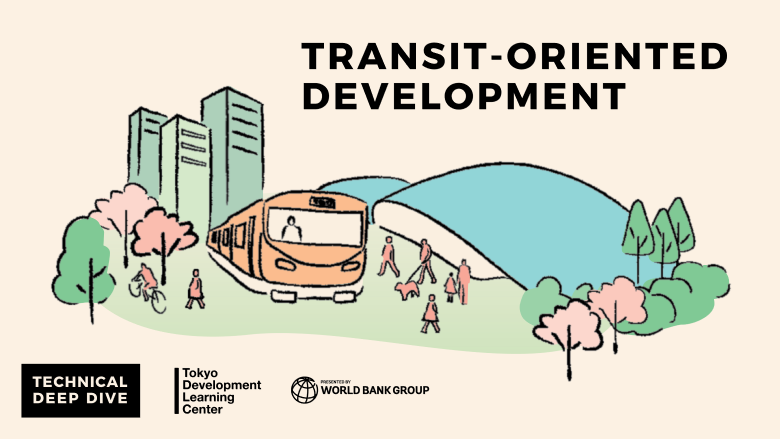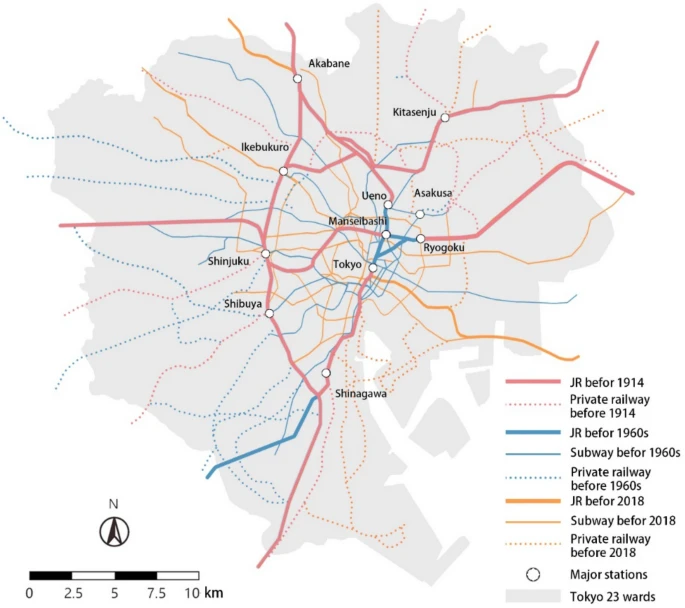Hey there, fellow urban explorers and transit nerds! I'm Jun, a big fan of public railway transportation service, who's spent way too many late nights geeking out over how places like Tokyo manage to feel both buzzing and blissfully efficient. Picture this: zipping through a metropolis on a sleek train, stepping off into a neighborhood that's got everything—cafes, shops, apartments, and green spaces—all within a short stroll. No sprawling parking lots, no endless traffic jams. That's the magic of Japan's transit-oriented development (TOD), and let me tell you, it's not some happy accident. It's baked into their laws, a system that's evolved over decades to make railways the heartbeat of sustainable cities.
 |
| web-japan.org |
I've always been fascinated by how Japan turned its post-war rebuild into a blueprint for smart growth. Back in the early 20th century, private railway companies like Hankyu and Tokyu were already onto something brilliant. They'd lay tracks and then weave in homes and businesses around stations, capturing the land value boom to fund more lines. Fast-forward to the 1950s–70s high-growth era, and you get massive "New Towns" like Tama, where rails anchored suburban dreams. But by the '80s, with Tokyo's core bursting at the seams (hello, 35 million in the metro area), things got serious. That's when national laws stepped in to formalize this railway-TOD love affair, pushing for public-private partnerships, clever land tools like readjustment, and incentives that keep everything compact and connected.
Let me walk you through the key laws that made this happen—think of it as my personal tour of Japan's urban playbook.
The Land Readjustment Act: The Unsung Hero of Self-Funded Cities
 |
| Guide to Rail Travel in Japan |
If there's one law that feels like the quiet engine room of Japan's TOD, it's the Land Readjustment Act from 1954 (with tweaks over the years). I remember poring over case studies and thinking, "How do they pull this off without bankrupting everyone?" Simple: It lets local governments and developers pool fragmented land plots from owners, redesign the whole area, and set aside 20–30% for public goodies like roads, parks, and—crucially—railway lines. Owners get back upgraded parcels of equal or better value, and the leftover land gets sold to cover costs. No massive tax hikes needed; it's practically self-financing.
For me, this clicked when I read about Yokohama's Minato Mirai 21 project in the '70s and '80s. Readjustment cleared the way for mixed-use zones hugging new rail lines, turning industrial waterfront into vibrant hubs. Over 30% of Japan's urban land has been reshaped this way, slashing rail acquisition costs by up to 50% and birthing walkable communities that make car-free living a no-brainer. It's the foundation that let everything else build on top.
Going Multi-Polar: The 1988 Act That Broke Tokyo's Monoculture
| List of through trains in Japan - Wikipedia |
By the late '80s, Tokyo was a pressure cooker—overconcentration leading to insane commutes and sprawl. Enter the Multi-Polar Patterns National Land Formation Promotion Act of 1988. This one hit me as a game-changer because it wasn't just about building; it was about redistributing the energy. The law flagged "business core cities" like Tsukuba and Kashiwa as sub-centers, doling out planning guidelines, subsidies, and zoning perks to spread the love beyond the capital.
What sealed it for TOD? It greenlit railway extensions to these spots, mandating that housing, offices, and shops cluster around stations to cut travel times and tame urban creep. Tied to the Fourth National Capital Region Development Plan, it prioritized rails over roads, shifting Japan from a starburst sprawl to a web of connected nodes. I love how it boosted ridership—take the Tsukuba Express; post-2005 launch, passengers jumped 20% yearly. Suddenly, these satellite cities weren't just dorms for Tokyo; they were thriving on their own terms.
The Housing-Railway Duo: 1989's Bold Bet on Integrated Living
 |
| Technical Deep Dive: Transit-Oriented Development - World Bank |
Hot on its heels came the Act on Special Measures concerning Comprehensive Advancement of Housing Development and Railway Construction in Metropolitan Areas—whew, try saying that three times fast. Nicknamed the Housing-Railway Development Law, it zeroed in on Tokyo's northern and western suburbs, where housing shortages met rail bottlenecks. I geeked out over its mechanics: "Special land readjustment zones" along future tracks, where governments, housing pros, and rail operators team up to assemble private plots. Replot them for corridors (handed over at fair value), sell off extras for dev funds, and boom—incentives like jacked-up floor-area ratios (up to 400%) for mixed-use magic.
This law straight-up required station-area blueprints packed with homes, retail, and public spots, with local targets for thousands of new units tied to rail launches. My favorite example? The 58-km Tsukuba Express, linking Akihabara to the sci-fi wonder of Tsukuba Science City. It spat out over 200,000 housing units, flipped the line to profitability by 2017 via land sales, and trimmed build costs by 30–40%. Value capture at its finest—rail sparks land hikes, which fund more TOD. It's like the system feeds itself.
The Bigger Picture: Laws That Layer and Last
 |
| Integrating Station-Area Development with Rail Transit Networks: Lessons from Japan Railway in Tokyo |
Of course, these aren't solo acts. The City Planning Act (1968, refreshed in 2019) sets the zoning stage, carving out "urbanization promotion areas" for rail-tied growth while fencing off sprawl. Then there's the 2002 Act on Special Measures concerning Urban Reconstruction, unleashing "Special Urban Renaissance Districts" around stations with looser height and use rules—think Tokyo's slick Takanawa Gateway redo. And don't sleep on the Railway Business Act (1986, post-JR privatization), which nudged operators into real estate side hustles, where non-fare cash (like 40% for private lines) fuels TOD loops.
Diving into this, I've seen how it's kept Tokyo's transit share above 60%, slashed emissions, and even exported the model worldwide via JICA. Sure, aging tracks and shrinking populations pose headaches, but 2020s updates—like smart city tie-ins—are keeping it fresh.
As I wrap this up, I'm reminded how exploring these laws has reshaped my own views on city-building. Japan's not perfect, but their rail-centric laws? They're a masterclass in harmony between people, place, and progress. If you're plotting your next trip, hit up a Tokyo suburb by train—you'll feel the difference.
A quick note: This post was crafted with the invaluable assistance of Grok, an AI built by xAI. Grok helped me sift through the details, structure my thoughts, and ensure the facts stayed sharp—because even us humans need a smart co-pilot sometimes. Thanks, Grok!
What about you? Ever ridden a Japanese rail that blew your mind? Drop a comment below—let's chat TOD dreams.
Safe travels,
Jun









.jpg)






